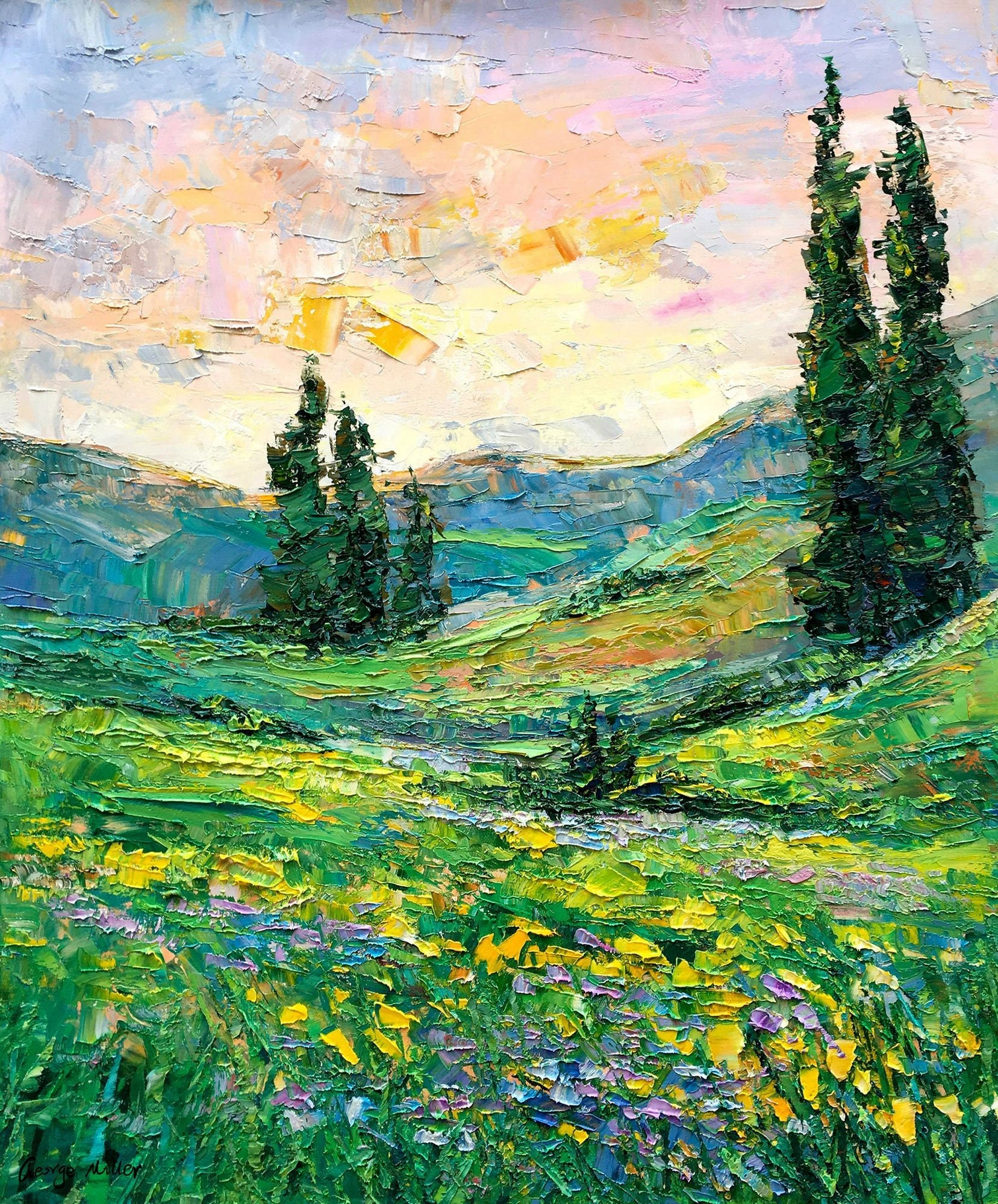Exploring Everything About Oil Paints: A Guide to Comprehending Their Beauty and Worth
Oil paintings have astounded audiences for centuries, offering a look right into the artistic proficiency of different ages. Their abundant history is linked with ingenious strategies and profound psychological expression. Understanding the products and techniques behind these artworks can enhance admiration. Furthermore, the marketplace for oil paintings presents chances for enthusiasts and capitalists alike. As one discovers this remarkable world, the question arises: what makes an oil paint really valuable?
The Background of Oil Paint: A Trip Via Time
Oil paint has roots that date back to ancient times, it genuinely prospered throughout the Renaissance, when artists discovered its adaptability and rich color capacity. Early instances can be traced to the 7th century, with strategies progressing especially across cultures. The medium came to be famous in Northern Europe in the 15th century, particularly with the jobs of artists like Jan van Eyck, who spearheaded its use for comprehensive realistic look and vivid colors. This duration noted a departure from tempera paints, enabling greater depth and texture. As oil painting spread, it influenced numerous musicians, causing work of arts by popular figures such as Leonardo da Vinci and Rembrandt. The medium's tradition continues, shaping the art world well right into modern-day times.
Understanding Oil Paints: Materials and Techniques
As artists check out the globe of oil paints, they experience a diverse variety of materials and strategies that specify this medium. The primary parts of oil paint include pigments, which supply shade, and drying oils, such as linseed, that bind the pigments and promote application. Numerous ingredients can customize the paint's texture and drying out time, improving convenience. Methods like glazing, where transparent layers are developed, and impasto, which includes using thick paint, enable various aesthetic impacts. Additionally, making use of brushes, palette knives, and also fingers can create distinct appearances and finishes. Understanding these techniques and materials makes it possible for artists to totally express their creative thinking and accomplish the preferred effect in their artwork.
The Duty of Shade in Oil Paints
Color plays a critical function in oil paints, affecting both aesthetic appeal and psychological vibration. Recognizing shade theory fundamentals, consisting of the relationships in between hues, can improve an artist's capability to share state of mind and atmosphere. In addition, mastering shade blending methods permits higher depth and richness in a painting's palette.

Shade Theory Basics
Understanding shade concept is vital for artists functioning with oil paints, as it creates the structure for developing visually engaging and harmonious structures. Shade theory includes the research of just how shades connect, the shade wheel, and the partnerships in between main, second, and tertiary shades. Musicians utilize corresponding shades to boost contrasts and produce centerpieces, while analogous colors advertise unity and cohesiveness within a piece. Furthermore, the concepts of cool and warm colors influence the understanding of deepness and room in a paint. Realizing these principles enables artists to control color efficiently, directing the visitor's eye and connecting their intended message. Mastery of color theory eventually enriches an artist's capability to share emotions and ideas with their work.
Psychological Influence of Color
The psychological effect of color in oil paintings plays an essential function in exactly how visitors link and regard with art work. Colors evoke details feelings and moods, influencing the customer's mood. As an example, cozy colors like reds and oranges can create a feeling of heat and power, while cool tones such as blues and environment-friendlies frequently evoke peace or introspection. Artists tactically choose shade palettes to enhance narrative aspects, directing the audience's emotional trip. The saturation and contrast of colors additionally intensify these results, drawing focus and developing focus. Ultimately, the interaction of colors in oil paints not only enhances their aesthetic appeal however also acts as an effective tool for emotional expression, enhancing the customer's experience and interpretation.
Color Mixing Techniques
While several facets of oil painting add to the overall composition, grasping shade mixing strategies is essential for achieving wanted effects and deepness. Shade mixing can be come close to with various methods, including the additive and subtractive procedures. Additive mixing involves combining colors of light, while subtractive blending counts on pigments, where shades blend to develop new tones. Musicians usually use a limited scheme to produce harmonious works, recognizing the connections in between primary, secondary, and tertiary shades. Strategies such as glazing and scumbling even more boost depth and luminance. By masterfully blending colors, a musician can stimulate feelings, create centerpieces, and accomplish a feeling of realistic look, inevitably boosting the painting's aesthetic and psychological influence.
Famous Oil Painters and Their Iconic Functions

Famous for their proficiency of color and technique, oil painters have developed a few of the most celebrated art work in background. Popular artists like Vincent van Gogh mesmerized audiences with his emotive brushwork in "Starry Evening," while Claude Monet's "Perception, Sunup" laid the groundwork for Impressionism. Leonardo da Vinci's "Mona Lisa" stays an enduring symbol of creative wizard, showcasing his skill in recording human expression. Rembrandt's "The Night Watch" highlights his cutting-edge use of light and shadow. Various other notable figures consist of Pablo Picasso, that transformed modern-day art with his vibrant experimentation in jobs like "Les Demoiselles d'Avignon," and Georgia O'Keeffe, whose lively depictions of blossoms and landscapes aided define American modernism. Each artist's special design added significantly to the oil paint landscape.
Just how to Assess the High Quality of an Oil Paint
Assessing the quality of an oil painting involves a careful analysis of workmanship strategies, as well as an analysis of color and structure. Observing brushwork, layering, and the application of paint can expose the musician's ability degree. Additionally, the interaction of shades and the general arrangement of elements add considerably to the painting's aesthetic value.
Analyzing Workmanship Techniques
A precise evaluation of craftsmanship strategies is important for determining the top quality of an oil paint. Evaluators should initially take a look at the application of paint; thick, textured brushstrokes may recommend a competent hand, while excessively consistent applications might show a lack of depth. oil paintings for sale. The layering method is additionally vital; the existence of glazes and differed thickness can enhance luminance and intricacy. In addition, the quality of the materials utilized, such as the canvas and pigments, plays a significant role in resilience and total aesthetic. Attention to detail in aspects like sides and changes between shades mirrors the musician's dedication to their craft. Eventually, these methods contribute click here to the painting's psychological impact and market price, functioning as indicators of the musician's ability and intent
Assessing Shade and Composition
While evaluating the top quality of an oil painting, one should concentrate on the interplay of shade and make-up, as these components are essential to the artwork's overall influence. Color options can develop and evoke feelings state of mind; consequently, the artist's combination ought to be taken a look at for harmony and contrast. A well-balanced structure routes the customer's eye and develops a sense of unity. Artists commonly utilize strategies like the policy of thirds or leading lines to boost aesthetic interest. In addition, the usage of light and darkness can include depth, enhancing the three-dimensionality of the painting. Ultimately, a successful oil painting weds color and composition, engaging the viewer and inviting a deeper gratitude of the musician's vision and strategy.
Caring for and Preserving Oil Paintings
Correct care and conservation of oil paints is essential for maintaining their stability and long life. To secure these art work, it is vital to show them far from direct sunlight, which can trigger fading and discoloration. Keeping a secure environment with regulated temperature level and humidity further help in stopping damages. Cleansing should be done carefully making use of a soft, completely dry fabric, preventing any type of harsh chemicals that can hurt the paint or varnish. Routine evaluations for indications of damage, such as breaking or flaking, are advisable. When carrying or saving oil paintings, appropriate padding and framing are needed to stay clear of physical harm. Ultimately, attentive treatment adds to the visual allure and value of oil paintings gradually.
The Market for Oil Paints: Gathering and Investing
Understanding the market dynamics for oil paintings is vital for financiers and collection agencies alike. The worth of these art work is influenced by numerous elements, including the artist's credibility, historical significance, and present patterns. Collectors typically seek pieces that reverberate directly while taking into consideration prospective appreciation in worth. Galleries and public auctions work as key locations for trading, with costs varying based upon need and rarity. Spending in oil paints needs research study into the marketplace, along with an understanding of credibility and provenance. Furthermore, arising musicians may provide opportunities for substantial returns, while developed names can regulate high costs. Generally, a calculated method to gathering can produce both aesthetic pleasure and economic incentives.

Often Asked Questions
What Are the Ecological Effects of Oil Painting Materials?
The ecological influences of oil painting materials include the release of unpredictable organic compounds (VOCs), dangerous waste generation, and source extraction for pigments. These aspects contribute to pollution and ecological degradation, raising concerns amongst environmentally conscious artists and customers.
Exactly How Do Different Canvases Influence Oil Paint Outcomes?
Different canvases influence oil paint results substantially. Surface, appearance, and absorbency high quality can modify paint application, drying out times, and shade vibrancy. Musicians commonly choose particular canvases to attain desired results and improve their creative expression.
Can Oil Paintings Be Brought Back if Damaged?
If damaged, Oil paintings can indeed be brought back. Expert conservators use various strategies to fix splits, clean surface areas, and address staining, ensuring that the artwork keeps its original beauty and worth for future generations.
What Are the Indicators of an Original Oil Painting?
The indicators of an original oil paint consist of noticeable brush strokes, texture variations, and an uneven canvas weave (oil paintings for sale). Furthermore, credibility might be confirmed with provenance, signatures, and the visibility of a varnish layer distinct to oil mediums
Just How Has Technology Influenced Modern Oil Paint Techniques?
Technology has actually significantly affected modern oil paint methods by introducing electronic tools for preparation, enhanced materials for structure and longevity, and on-line systems for selling and sharing art, therefore expanding musicians' innovative possibilities and audience reach. Oil painting has origins that date back to old times, it absolutely flourished during the Renaissance, when musicians discovered its convenience and rich shade possibility. The emotional effect of shade in oil paintings plays an essential duty in exactly how viewers link and view with artwork. While several elements of oil painting add to the total make-up, understanding shade mixing techniques is vital for achieving wanted results and depth. Reviewing the high quality of an oil paint involves a mindful evaluation of workmanship techniques, as well as an evaluation of shade and structure. While assessing the top quality of an oil painting, one need to concentrate on the interplay of color and structure, as these aspects are fundamental to the art work's overall effect.